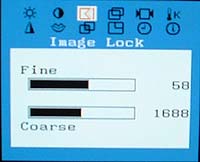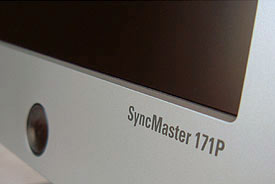|

|
The 171P Syncmaster display from Samsung is a 17" LCD monitor designed by brilliant minds at F.A. Porsche.
92% Rating: 
|
|
|
|
Home >
Reviews >
Monitors >
Samsung 171P |
|
|
LCD Display Evaluation Notes
 The on screen display is something that we as users only
interact with when something about the monitor is ary. In those instances the
last thing we really want to see is an amazing complex menu which we cannot
quickly move through, or get to the controls we
need to adjust. The on screen display is something that we as users only
interact with when something about the monitor is ary. In those instances the
last thing we really want to see is an amazing complex menu which we cannot
quickly move through, or get to the controls we
need to adjust.
Of the monitors
we have looked at in the last little while, the Samsung displays have had
some of the most advanced and intuitive. The 171P follows suite and
continues to use the same OSD that all 2002 model LCD monitors from Samsung
have been using.
The OSD does some neat (and pretty pointless) things like being able to
halftone, or move to different areas of the screen. Realistically speaking, I
don't believe there are many people out there who really need "features" like
these, but I suppose someone ultimately will write in saying they do.
The on screen menus appear as follows and allow the user
to adjust these display parameters: Brightness;
Contrast; Image Lock: Coarse, Fine; Position: H/V; Color Control:
Red, Green, Blue; Color Reset: Geometry, Color; Image Size:
Normal, Expand 1 &2; Image Effect: Scaling on/off, Filtering;
Language: English, German, Spanish, French, Italian, Swedish; OSD
Position: H/V; OSD Display Time: 5, 10, 20, 200 seconds; and Display
Mode: Hl/V Frequency & Resolution.
| PCstats TFT Display Evaluation
Criteria: |
|
We
evaluate the quality of TFT displays with the help of a program called
Nokia Monitor Test. The software application displays a range of colours
and test patterns that can help diagnose just about any visual problems or
defects a TFT display may contain.
It can also be a very useful tool for
properly adjusting a display to the optimal settings. The software
consists of eleven tests which can be run in steps as adjustments are made
to the OSD. As the tests are run we look for the following problems, only
one of which should be inoperable (broken pixel).
Broken Pixels: What we class as a 'broken pixel' can
fall under any one of the following circumstances: Pixel always on (any
colour), pixel always off, pixel unable to display a shade (red, green,
blue, black, white), pixel shown colour gradient.
Pixel Clock: If the number of dot clocks within one
horizontal synch are not properly configured the screen will appear to
drift or vertical stripes may be generated. This should be correctable by
the on screen menu.
Phase: If the phase of the display data and dot clock
are not correctly tuned the screen can flicker, or text be displayed
blurry. For example text may appear dithered, or when looking at a test
pattern of a one-pixel black, one-pixel white checkerboard pattern the
pattern may be distorted. This should be correctable by the on screen
menu.
Response Time: We look for any streaking associated
with moving a full page of text up or down quickly. Displays with slower
refresh rates tend to show some degree of image streaking or text
discoloration which can be distracting.
Stand Stability: TFT displays are fragile components and the
stand should offer adequately stable support as well as be easily
adjustable.
We deduct marks for quality control if there are any predominant
broken pixels in a display. While many manufacturers may consider a
few broken pixels acceptable, we believe the high cost of TFT displays
should translate into a clear and unblemished image. |
|
| Display Test System
Configuration: |
| Video Card: |
ATI Radeon 8500 |
| Operating System: |
MS
Windows 2000 |
| Display Settings: |
Color Temp: 6500 Kelvin
Resolution: 1280x1024
pixels
Frequency: 60Hz
Colour: 32
Bit | |

|
| LCD Display Test |
Overall |
Test Notes and Observations |
|
| Geometry: |
Pass |
LCD's inherent design means that test grids are displayed very true and very square. In
this sense, LCD displays are really good for CAD work as the
line render nice and sharp at the native 1280x1024 resolution. THe 171P displayed very bright
test grids
|
| Brightness and Contrast: |
Pass |
Good shading on the grey scale, but
almost undetectable differences on the 1% to 9% white scale.
|
| Colour: |
Pass |
The white,
red, green and blue test screens were all very bright and consistent over the entire screen area.
There were no visible broken pixels or uneven areas.
|
| Convergence: |
Pass |
The grid test patterns in RGB illustrate the worst case situations when different coloured pixels must
work closely together, and since they comprise different parts of a pixel
they do not line up exactly. CRT displays tend to
produce better results under this test as there is more of a blending processor
going on.
|
| Focus: |
Pass |
All patterns are clearly visible and defined in
both the horizontal and vertical axis. With such a high contrast ratio the
lines are easily distinguishable.
|
| Resolution: |
Pass |
Resolution
is excellent at the
native 1280x1024 resolution. The image scaling algorithm is very good at non-native resolutions
like 1024x768.
|
| Moire: |
Pass |
None of the test patterns exhibited any problems
displaying the various grey scale and
line test patterns. There were no Moire lines visible which
is very good to see.
|
|
Other Evaluation Notes: |
Pass |
The stand swivels left and right very nicely which
is a change for Samsung which have previously been
plagued with less than idea plastic castors. The vertical adjustments work better than on previous displays and
in general the entire feel of the unit is
nice.
|
|
|
|
|
|
|
|
|
